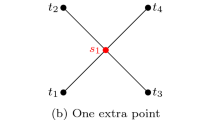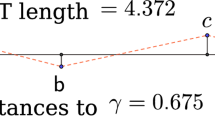Abstract
The Steiner tree problem in Euclidean space \(E^3\) asks for a minimum length network \(T\), called a Euclidean Steiner Minimum Tree (ESMT), spanning a given set of points. This problem is NP-hard and the hardness is inherently due to the number of feasible topologies (underlying graph structure of \(T\)) which increases exponentially as the number of given points increases. Planarity is a very strong condition that gives a big difference between the ESMT problem in the Euclidean plane \(E^2\) and in Euclidean \(d\)-space \(E^d (d\ge 3)\): the ESMT problem in the plane is practically solvable whereas the ESMT problem in \(d\)-space is really intractable. The simplest tree rearrangement technique is to repeatedly replace a subtree spanning four nodes in \(T\) with another subtree spanning the same four nodes. This technique is referred to as the Swapping 4-point Topology/ Tree technique in this paper. An indicator (or quasi-indicator) of \(T\) plays a similar role in the optimization of the length \(L(T)\) of \(T\) in the discrete topology space (the underlying graph structure of \(T\)) to the derivative of a differentiable function which indicates a fastest direction of descent. \(T\) will be called S4pT-optimal if it is optimal with respect to swapping 4-point subtrees. In this paper we first make a complete analysis of 4-point trees in Euclidean space exploring all possible types of 4-point trees and their properties. We review some known indicators of 4-point ESMTs in \(E^2\), and give some simple geometric proofs of these indicators. Then, we translate these indicators to \(E^3\), producing eight quasi-indicators in \(E^3\) using computational experiments, the best quasi-indicator \(\rho _\mathrm{osr}\) is sifted with an effectiveness for randomly generated 4-point sets as high as 98.62 %. Finally we show how \(\rho _\mathrm{osr}\) is used to find an S4pT-optimal ESMT on 14 probability vectors in \(4d\)-space with a detailed example.











Similar content being viewed by others
References
Badri, T.N.: Steiner minimal trees in three-dimensional Euclidean space. PhD Dissertation, University of Massachusetts, USA http://scholarworks.umass.edu/dissertations/AAI3039336 (2002)
Brazil, M., Grossmann, P.A., Lee, D.H., Rubinstein, J.H., Thomas, D.A., Wormald, N.C.: Decline design in underground mines using constrained path optimisation. Min. Technol. Trans. Inst. Min. Metall. Sect. A 117, 93–99 (2008)
Brazil, M., Thomas, D.A., Nielsen, B.K., Winter, P., Wulff-Nilsen, C., Zachariasen, M.: A novel approach to phylogenetic trees: d-dimensional geometric Steiner trees. Networks 53(2), 104–111 (2009)
Du, D.-Z., Hu, X.: Steiner Tree Problems in Computer Communication Networks. World Scientific, Singapore (2008)
Du, X., Du, D.-Z., Gao, B., Que, L.: A simple proof for a result of Ollenrenshaw on Steiner trees. In: Du, D.-Z., Sun, J. (eds.) Advances in Optimization and Approximation, pp. 68–71 (1994)
Ewens, W.J., Grant, G.R.: Statistical Methods in Bioinformatics: An Introduction. Springer, USA (2005)
Fampa, M., Anstreicher, K.M.: An improved algorithm for computing Steiner minimal trees in Euclidean \(d\)-pace. Discret. Optim. 5(2), 530–540 (2008)
Felsenstein, J.: Inferring Phylogenies. Sinauer Associates Inc, Sunderland (2004)
Garey, M.R., Graham, R.L., Johnson, D.S.: The complexity of computing Steiner minimal trees. SIAM J. Appl. Math. 32, 835–859 (1977)
Gilbert, E.N., Pollak, H.O.: Steiner minimal trees. SIAM J. Appl. Math. 16, 1–29 (1968)
Grant, M., Boyd, S.: CVX: Matlab software for disciplined convex programming, version 1.21 (2011)
Hwang, F.K., Richards, D.S., Winter, P.: The Steiner Tree Problem, Annals of Discrete Mathematics, 53rd edn. Elsevier Science Publishers, Amsterdam (1992)
Karp, R.M.: Ruducibility among combinatorial problems. In: Miller, R.E., Thatcher, J.W. (eds.) Complexity of Computer Computations, pp. 85–103. Plenum Press, New York (1972)
Melzak, Z.A.: On the problem of Steiner. Can. Math. Bull. 4, 143–148 (1961)
Mondaini, R. P.: Euclidean full Steiner trees and the modelling of biomolecular structures In: Proceedings of the Biomat, pp. 247–258 (2006)
Ollerenshaw, K.: Minimum networks linking four points in a plane. Inst. Math. Appl. 15, 208–211 (1978)
Pollak, H.O.: Some remarks on the Steiner problem. J. Comb. Theor. Ser. A 24, 278–295 (1978)
Rubinstein, J.H., Thomas, D.A.: A variational approach to the Steiner network problem. Ann. Oper. Res. 33, 481–499 (1991)
Rubinstein, J.H., Thomas, D.A., Weng, J.F.: Minimum networks for four points in space. Geometriae Dedicata 93, 57–70 (2002)
Smith, W.D.: How to find Steiner minimal trees in Euclidean \(d\)-space. Algorithmica 7, 137–177 (1992)
Smith, J.M., Jang, Y., Kim, M.K.: Steiner minimal trees, twist angles, and the protein folding problem, proteins: structure. Funct. Bioinform. 66, 889–902 (2007)
Takahashi, K., Nei, M.: Efficiencies of fast algorithms of phylogenetic inference under the criteria of maximum parsimony, minimum evolution, and maximum likelihood when a large number of sequences are used. Mol. Biol. Evol. 17, 1251–1258 (2000)
Tria, F., Caglioti, E., Loreto, V., Pagnanil, A.: A stochastic local search algorithm for distance-based phylogeny reconstruction. Mol. Biol. Evol. 27, 2587–2595 (2010)
Weng, J.F.: Generalized Steiner problem and hexagonal coordinate system (in Chinese). Acta Math. Appl. Sinica 8, 383–397 (1985)
Weng, J.F.: Variational approach and Steiner minimal trees on four points. Discret. Math. 132, 349–362 (1994)
Weng, J.F.: Steiner trees, coordinate systems and NP-hardness. In: Du, D.-Z., Smith, J.M., Rubinstein, J.H. (eds.) Advances in Steiner Trees, pp. 63–80. KluwerAcademic Publishers, London (2000)
Weng, J.F.: Identifying Steiner minimal trees on four points in space. Discret. Math. Algorithms Appl. 1, 401–411 (2009)
Weng, J.F., Smith, J.M., Brazil, M., Thomas, D.A.: Equivalence, indicators, quasi-indicators and optimal Steiner topologies on four points in space. Fundamenta Informaticae 84, 135–149 (2008)
Weng, J.F., Thomas, A., Mareels, I.: Maximum parsimony, substitution model and probability phylogenetic trees. J. Comput. Biol. 18, 67–80 (2011)
Weng, J.F., Mareels, I., Thomas, D.A.: Probability Steiner trees and maximum parsimony in phylogenetic analysis. J. Math. Biol. 64(7), 1225–1251 (2012)
Author information
Authors and Affiliations
Corresponding author
Rights and permissions
About this article
Cite this article
Thomas, D.A., Weng, J.F. Euclidean Steiner trees optimal with respect to swapping 4-point subtrees. Optim Lett 8, 1337–1359 (2014). https://doi.org/10.1007/s11590-013-0660-3
Received:
Accepted:
Published:
Issue Date:
DOI: https://doi.org/10.1007/s11590-013-0660-3




